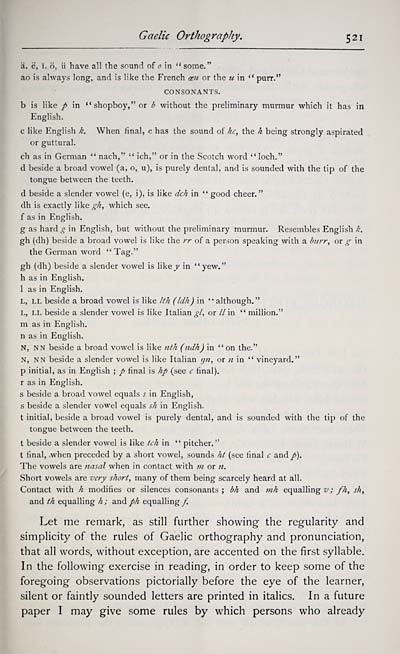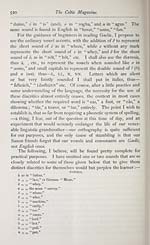Blair Collection > Celtic magazine > Volume 12
(531)
Download files
Complete book:
Individual page:
Thumbnail gallery: Grid view | List view

Gaelic Orthography. 521
a, e, i. o, ii have all the sound o{ o in "some."
ao is always long, and is like the French mc or the u in " purr."
CONSONANTS.
b is like / in "shopboy," or b without the preliminary murmur which it has in
English.
c like English k. When final, c has the sound oi he, the h being strongly aspirated
or guttural,
eh as in German " nach," " ich," or in the Scotch word "loch."
d beside a broad vowel (a, o, u), is purely dental, and is sounded with the tip of the
tongue between the teeth,
d beside a slender vowel (e, i), is like dcli in " good cheer."
dh is exactly like gh, which see.
f as in English.
g as hard g in English, but without the preliminary murmur. Resembles English k.
gh (dh) beside a broad vowel is like the rr of a person speaking with a burr, or g in
the German word "Tag."
gh (dh) beside a slender vowel is like/ in "yew."
h as in English.
1 as in English.
L, LL beside a broad vowel is like 1th (Idh) in "although."
L, LL beside a slender vowel is like Italian gl, or //in " million."
m as in English.
n as in English.
N, NN beside a broad vowel is like nth (ndh) in "on the."
N, NN beside a slender vowel is like Italian c/w, or « in " vineyard."
p initial, as in English ; / final is hp (see c final),
r as in English.
s beside a broad vowel equals s in English,
s beside a slender vowel equals sk in English.
t initial, beside a broad vowel is purely dental, and is sounded with the tip of the
tongue between the teeth.
t beside a slender vowel is like tch in " pitcher. "
t final, .when preceded by a short vowel, sounds ht (see final c and/).
The vowels are nasal when in contact with tn or n.
Short vowels are very short, many of them being scarcely heard at all.
Contact with h modifies or silences consonants ; bh and tnk equalling v ; fh, sh,
and th equalling h; and ph equalling yC
Let me remark, as still further showing the regularity and
simplicity of the rules of Gaelic orthography and pronunciation,
that all words, without exception, are accented on the first syllable.
In the following exercise in reading, in order to keep some of the
foregoing observations pictorially before the eye of the learner,
silent or faintly sounded letters are printed in italics. In a future
paper I may give some rules by which persons who already
a, e, i. o, ii have all the sound o{ o in "some."
ao is always long, and is like the French mc or the u in " purr."
CONSONANTS.
b is like / in "shopboy," or b without the preliminary murmur which it has in
English.
c like English k. When final, c has the sound oi he, the h being strongly aspirated
or guttural,
eh as in German " nach," " ich," or in the Scotch word "loch."
d beside a broad vowel (a, o, u), is purely dental, and is sounded with the tip of the
tongue between the teeth,
d beside a slender vowel (e, i), is like dcli in " good cheer."
dh is exactly like gh, which see.
f as in English.
g as hard g in English, but without the preliminary murmur. Resembles English k.
gh (dh) beside a broad vowel is like the rr of a person speaking with a burr, or g in
the German word "Tag."
gh (dh) beside a slender vowel is like/ in "yew."
h as in English.
1 as in English.
L, LL beside a broad vowel is like 1th (Idh) in "although."
L, LL beside a slender vowel is like Italian gl, or //in " million."
m as in English.
n as in English.
N, NN beside a broad vowel is like nth (ndh) in "on the."
N, NN beside a slender vowel is like Italian c/w, or « in " vineyard."
p initial, as in English ; / final is hp (see c final),
r as in English.
s beside a broad vowel equals s in English,
s beside a slender vowel equals sk in English.
t initial, beside a broad vowel is purely dental, and is sounded with the tip of the
tongue between the teeth.
t beside a slender vowel is like tch in " pitcher. "
t final, .when preceded by a short vowel, sounds ht (see final c and/).
The vowels are nasal when in contact with tn or n.
Short vowels are very short, many of them being scarcely heard at all.
Contact with h modifies or silences consonants ; bh and tnk equalling v ; fh, sh,
and th equalling h; and ph equalling yC
Let me remark, as still further showing the regularity and
simplicity of the rules of Gaelic orthography and pronunciation,
that all words, without exception, are accented on the first syllable.
In the following exercise in reading, in order to keep some of the
foregoing observations pictorially before the eye of the learner,
silent or faintly sounded letters are printed in italics. In a future
paper I may give some rules by which persons who already
Set display mode to: Large image | Transcription
Images and transcriptions on this page, including medium image downloads, may be used under the Creative Commons Attribution 4.0 International Licence unless otherwise stated. ![]()
| Early Gaelic Book Collections > Blair Collection > Celtic magazine > Volume 12 > (531) |
|---|
| Permanent URL | https://digital.nls.uk/76466871 |
|---|
| Description | Volume XII, 1887. |
|---|---|
| Shelfmark | Blair.13 |
| Attribution and copyright: |
|
| Description | A selection of books from a collection of more than 500 titles, mostly on religious and literary topics. Also includes some material dealing with other Celtic languages and societies. Collection created towards the end of the 19th century by Lady Evelyn Stewart Murray. |
|---|
| Description | Selected items from five 'Special and Named Printed Collections'. Includes books in Gaelic and other Celtic languages, works about the Gaels, their languages, literature, culture and history. |
|---|

